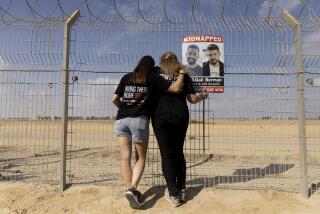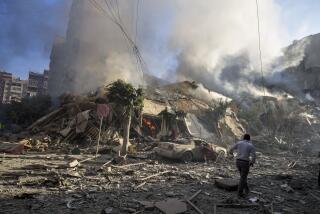Forecast for Mideast: Hazy, with chance of democracy

The great Yogi Berra is said to have observed, âPredictions are difficult, particularly about the futureâ (or something very close to that). When UCLA history professor James Gelvin quoted Berra to that effect on Saturday, it served as a capstone to a wide-ranging discussion of the Middle East in the aftermath of the Arab Spring.
Wait, scratch that. The term preferred by the panel of Mideast experts speaking at the Los Angeles Times Festival of Books was Arab Uprisings, not Arab Spring. The latter term implies some sort of positive trajectory toward a happy future, said Dalia Dassa Kaye, director of the Center for Middle East Public Policy at Rand Corp. The reality, she said, is far messier and more unpredictable.
Still, Kaye -- co-author of âIsrael and Iran: A Dangerous Rivalry,â (Rand Corp., 2011) -- is among those who believe that the various Arab democracy movements will eventually lead to improvements in the region. âI think in the long run, there are very many positive things,â she said. In the shorter term, however, she sees âlots of very disturbing developmentsâ and âdire challenges that the U.S. and others are facing.â
Karen Elliott House, retired publisher of the Wall Street Journal, agreed with Kaye, but said the long run could be quite long. âI think if you look at the region over the next 10 to 20 years, itâs going to be extremely unsettled and have a lot of unpleasant and unproductive events occur,â she said. âSo it will get a lot worse ... before it gets better.â
Worse, as in Syria, which all panelists agreed is likely to face a very difficult future. Gelvin, whose most recent book is latest book is âThe Arab Uprisings: What Everyone Needs to Knowâ (Oxford University Press, 2012), posed three possible outcomes for the current civil war in Syria: Outright victory for the opposition, outright victory for President Bashar Assad, or a stalemate that causes Syria to follow a failed-state path similar to Somaliaâs.
Of the three, he said, the last is the most likely.
The good news for the United States, all three panelists agreed, is that anything short of victory for Assad would be a blow to Iran, which has supported the Assad regime and has used Syria as a land bridge to resupply its Hezbollah clients in Lebanon. Moreover, Kaye argued, social media have helped give Iranâs repressive regime a bad reputation in the region. âTheir model does not resonate,â she said. âAnd thatâs a good news story.â
There also seemed to be agreement that the United States does not necessarily need to lead the resistance to Iranâs acquisition of a nuclear weapon. Arab states, especially Saudi Arabia, are at least as interested as the U.S. (although perhaps not as much as Israel) in the outcome, the panelists suggested.
The Saudis see Iran as their chief rival for influence in the region, and House, author of the recently published âOn Saudi Arabia - Its People, Past, Religion, Fault Lines -- and Futureâ (Knopf, 2012), said the Saudis and other Arab states need to take more of a lead role in standing up to the Iranians. âLet them protect themselves, let them stick their heads up, let them be accountable,â she said.
ALSO:
USC president, Times execs welcome festival-goers
Iraqis vote in provincial elections amidst angst and ire
Protests and clashes as Bahrain prepares for Grand Prix
More to Read
Sign up for our Book Club newsletter
Get the latest news, events and more from the Los Angeles Times Book Club, and help us get L.A. reading and talking.
You may occasionally receive promotional content from the Los Angeles Times.






